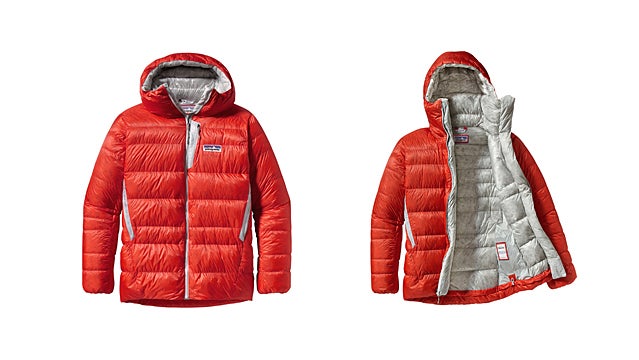You see strange things when you head up R&D at Patagonia. Like goose down floating in illuminated tubes. You go to strange places. Like secret labs inside white-washed corporations in Austin, Texas.
For five years, Randy Harward was on a quest to build the “best down parka ever made.” Those are Harward's words to describe the Encapsil Down Belay Parka, a puffy monster debuted to the public late yesterday. It has a heretofore unheard of 1,000-fill insulation rating. It costs $699.
Money was no concern, Harward said, during the R&D phase, which began in 2008. This included climbing trips and backcountry ski outings as well as research at labs in Silicon Valley. Along the way, Patagonia acquired a major stake in a Texas “advanced materials” company, , which is where the vacuum tubes and lab coats came into play. “A little chemistry gave us the extra fill power,” explained Harward, who is a materials guru as well as a vice president at Patagonia.
The company got a patent on its down-enhancing technology, branded Encapsil. It built a proprietary process with AeonClad that converts 800-fill down into the superfine 1,000-fill via radio waves, plasma chambers, “shifted” molecular structures, and other nano-chemical juju. In English, this means the fine plumes on goose down are made even finer by the AeonClad machine. It makes the plumes longer, stronger, more insulating, and resistant to water, according to Patagonia.
Lab-speak aside, I decided to give the parka a test. ���ϳԹ��� was sent a prototype of the jacket around Christmas. I zipped on the bright red, beyond-puffy piece on a trip in January to Minnesota's North Shore.
Wind whipped off Lake Superior. The winter sun hung low all day in the sky. I wore only a T-shirt under the Encapsil Parka as I trekked through snow into the forest for a view, and I was warm. In temps down to about 10 degrees Fahrenheit the parka kept me warm with just the thin base underneath. I was hot when I hiked hard uphill, the jacket performing more like a high-altitude mountaineering suit than a regular puffy.
Its hood is amazingly thick, a mummy sleeping bag feel. The body of the parka lofts to about 1.5 inches thick with the 1,000-fill puffiness. You can see the mottled pattern of the down feathers through a semi-transparent interior fabric. The stitching is fine and exact. Patagonia touts the construction is “independently baffled and differentially cut,” a complex pattern of down-stuffed chambers the company cites as another first. Packed up, the parka is about the size of a football. It weighs 18 ounces in a size large.
Because it's sold as water-resistant, I did my own lab test with the parka at home. Under a sink, tap water ran off its Pertex face fabric. It was difficult to soak the parka through even under the hard flow of a faucet. But it is not a raincoat. Water runs off the fabric face, which has a polyurethane coating, but it doesn't bead up. Once soaked through, the goose down does clump some. But it still retains its puff to an extent, as well as some warmth, even when torrentially soaked. I was impressed.
With a wet arm I went outside. After a few minutes of moving, the down was already starting to re-puff itself up and regain its insulation value. The plasma treatment was ostensibly doing its trick. More impressed.
The next week, on a final call with Patagonia, I talked to Harward about the future of Encapsil and down jackets. I asked if 1,000-fill is a current limit of practical puff. “We are making new discoveries every week,” he said. “We're working on a 1,200-fill now.”

